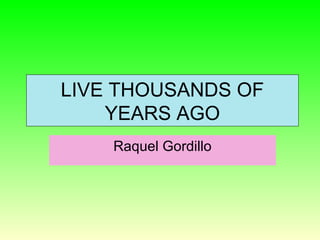
Live thousands of years ago
- 1. LIVE THOUSANDS OF YEARS AGO Raquel Gordillo
- 2. Pompeii: a city buried under ashes Almost 2,000 years ago, in Ancient Rome, the volcano Vesuvius erupted. Vesuvius buried the nearby town of Pompeii under six metres of volcanic ash and pumice. In 1592, archaeolgists discovered this buried town. Surprisingly, most of Pompoii remained intact. Today, you can walk through the ruins of Pompeii and imagine what life was like 2,000 years ago. Thanks to this discovery, we know that temples , palaces, public baths and shops existed thousands of years ago.
- 3. WHAT DO YOU REMEMBER? FAMILY HISTORY Family history is made up of memories. Our grandparents and parents have memories about their lives. We also have memories of when we were younger. These memories help us find out about the history of our family. THE PASSING OF TIME Everything chages with time: people, customs, objects and the landscape. History helps us to know how people lived many years ago.
- 4. HOW PRIMITIVE HUMAN BEINGS LIVED Life in primitive times Many thousands of years ago, human beings to lived in small groups called tribes. They ate plants and hunted animls for food. Tribes travelled from place to place to find fresh food. They lived near rivers to obtain fresh water. They made simple huts from branches and animal skins, or they lived in caves. Later, human beings learned to cultivate plants and domesticate animals. They built permanent villages with simple houses and stables for their animals. They built storehouses to keep their harvests in. Life was very hard many thousands of years ago. Clay pots were used for storing, transporting and cooking food.
- 5. TRAVELLING IN PRIMITIVE TIMES • The first human beings travelled on foot. • They carried all their belongings on their backs. • They travelled very slow. • They domesticated animals, such as horses and dogs. • They invented the wheel and they made the first carts. • They built the first sailing boats. • Humans could transport more people and more merchandise. • Travelling became easier and faster.
- 6. ANCIENT REMAINS • The first human beings decorated cave walls with paintings. They decipted the animals they hunted , such as deer and bison. • Tools were very simple. Humans shaped knives and arrowheads. They also made spears and harpoons from wood or bone. • To made clay pots they shaped the fresh clay. Then, they cooked the pots over a fire. Cave painting in Altamira, Cantabria The artists used different colours. The uneve surface of the cave walls gives volume to the paintings. Primitive tools They were used for hunting and fishig.
- 7. ROMAN TIMES LIFE IN ANCIENT ROME Over 2,000 years ago, the Romans built many cities. They lived in different types of houses: -Domus were private houses for rich people. They were large homes with an atrium, or patio, in the centre to let in light. -INSULAE were apartament for the poorer people. They had three or four storeys. Most Romans lived in an insulae. These buildings were crowed and uncomfortable. -VILLAS were luxury Roman country houses where rich land owners lived. Domus. The atrium had a pool to collect rainwater.
- 8. TRAVELLING IN ANCIENT ROMAN Roman cities were linked by straight roads made of stone. The Romans used the roads to travel on foot, on horseback and in horse-drawn carriages. They built many road bridges over rivers. Sailing boats were used for carry food and merchandise to other Roman cities. For this reason, the Romans built large seaports.
- 9. Roman remains The Romans were excelent builders. In fact, many of their contructions are still standing today. They built: • Theatres for performing plays. • Amphiteatres for watching gladiator fights. • Circuses for wathing chariot races. • Temples for worshipping their gods. • Bath houses, called thermae, for bathing and relaxing. • Aqueducts for transporting water to the cities. The Romans decorated their houses with works of art: • Frescos were beautiful wall paintins. • Mosaics were elaborate floor decorations made from thousands of tiny, coloured tiles.
- 10. MEDIEVAL TIMES Life in medieval times 1,000 years ago, noblemen lived in castles with their family, servants and soldiers. To
